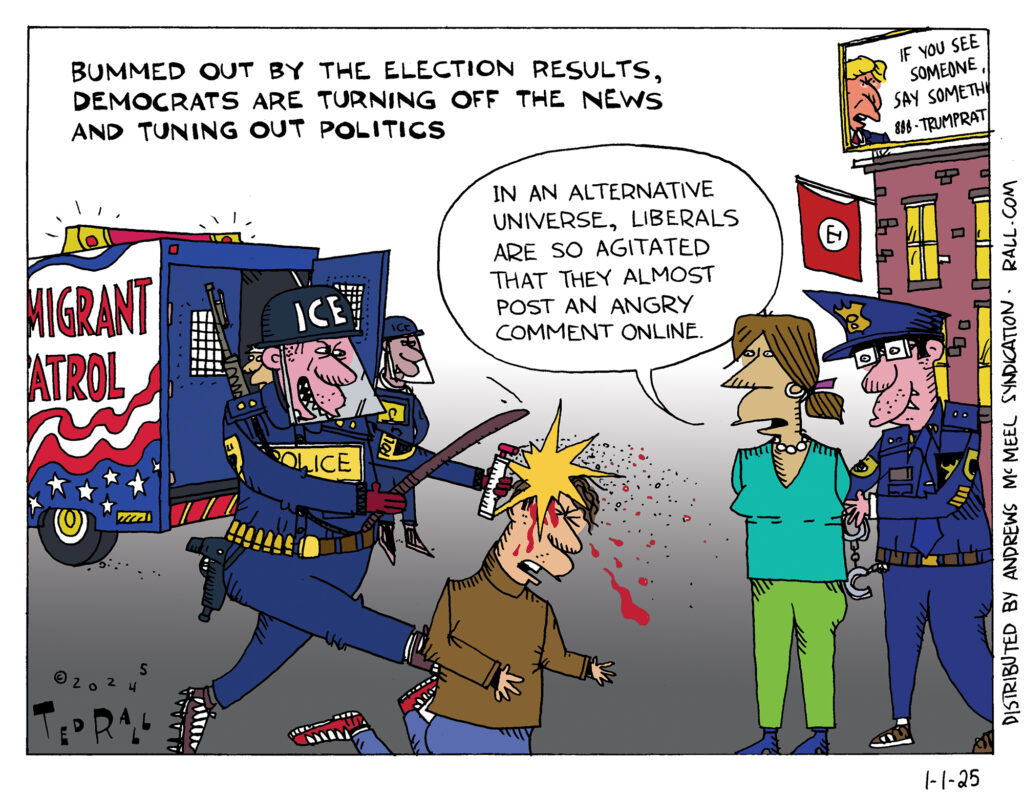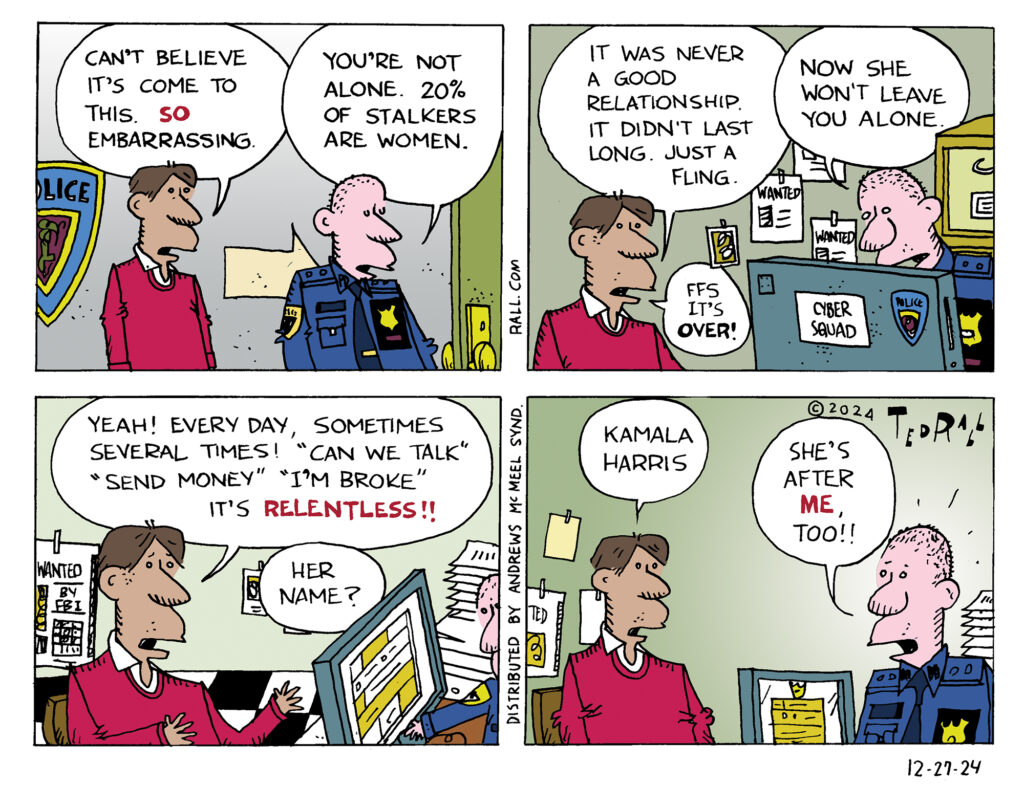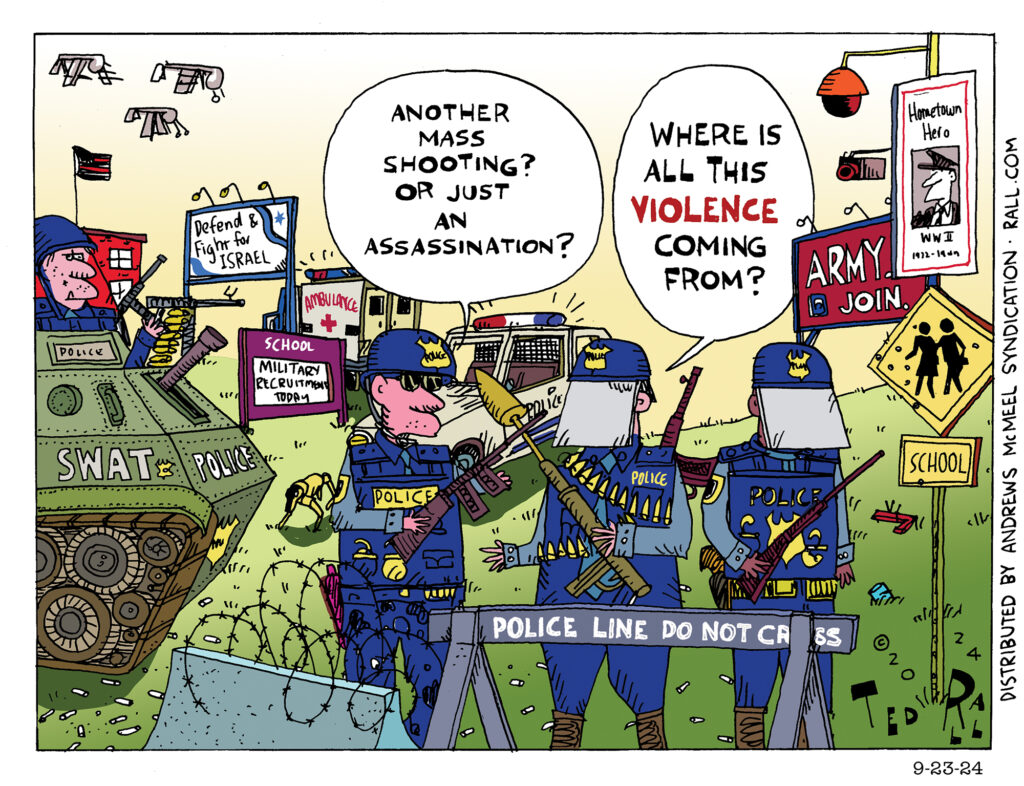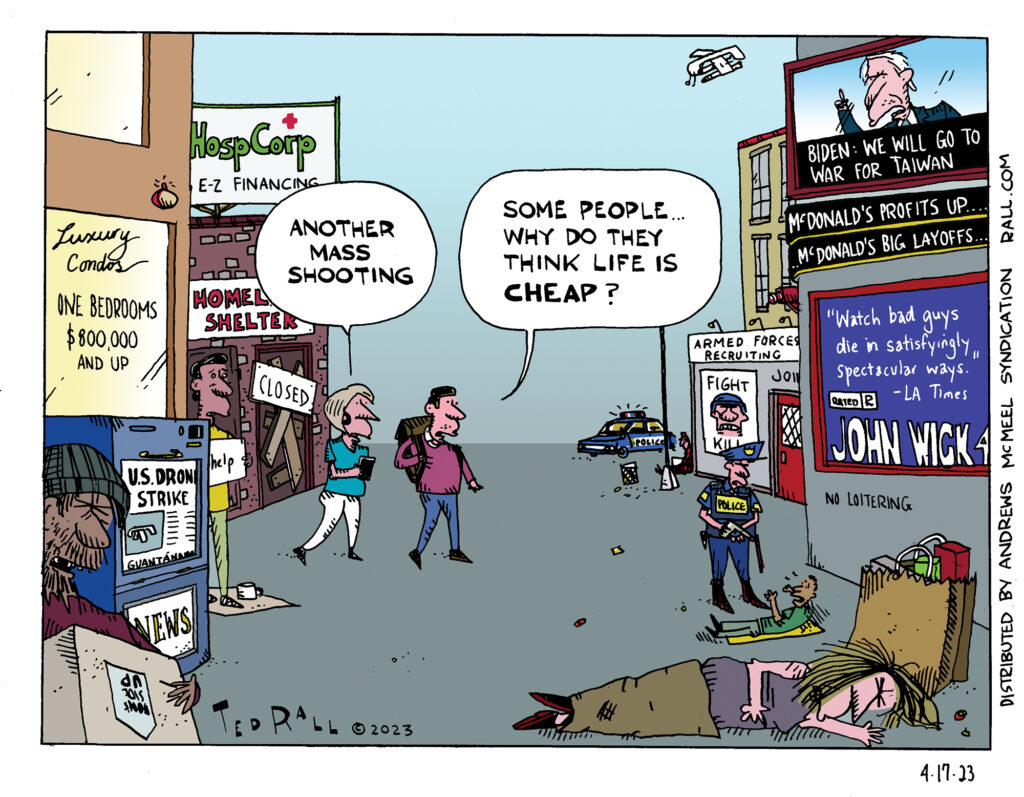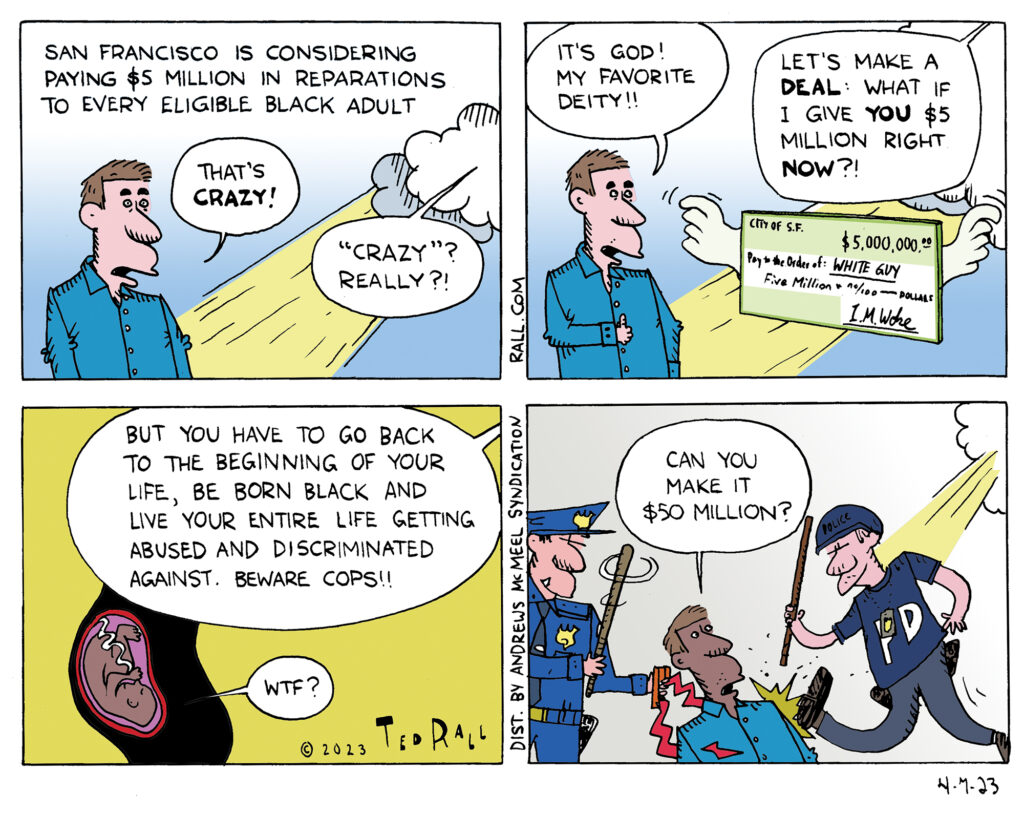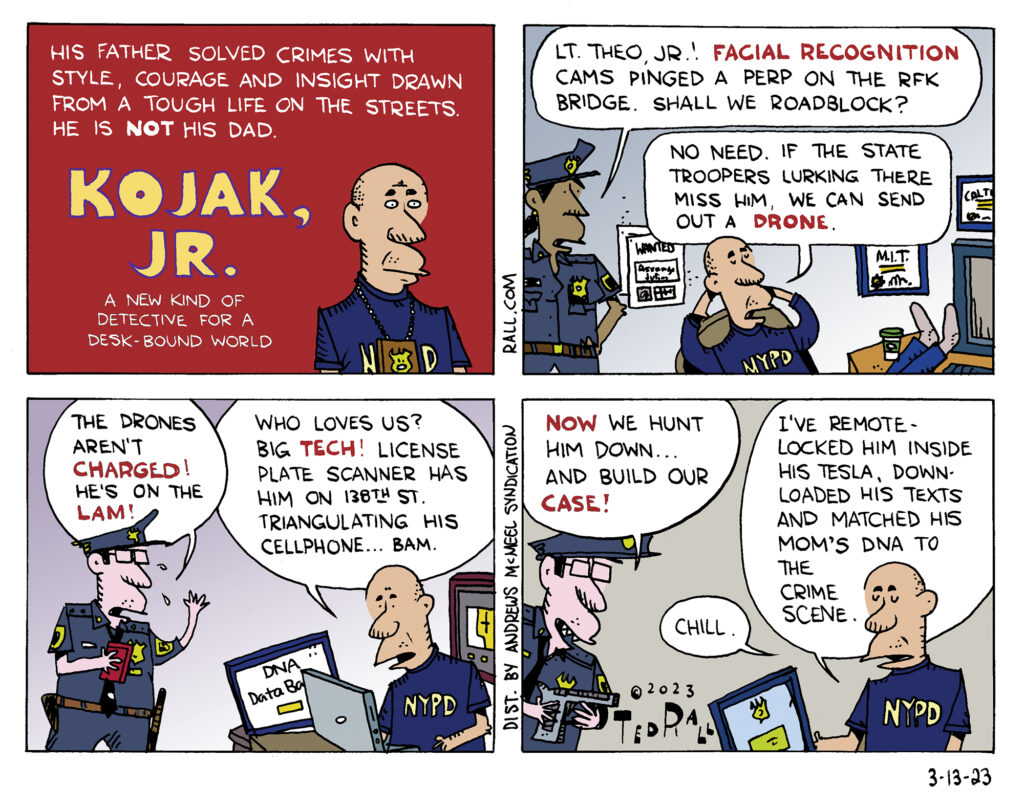Bummed out by the election results, liberals are turning off the news and tuning out politics. This will only help Trump in his mass deportations and other actions liberals claim to deplore.
Are Killers Insane?
 As is typically the case after a high-profile murder, people are speculating about suspect Luigi Mangione’s state of mind when he allegedly killed United Healthcare CEO Brian Thompson outside a Hilton hotel in Manhattan.
As is typically the case after a high-profile murder, people are speculating about suspect Luigi Mangione’s state of mind when he allegedly killed United Healthcare CEO Brian Thompson outside a Hilton hotel in Manhattan.
We have a likely (political) motive in the form of a handwritten statement Pennsylvania police say they found on Mangione when they arrested him. “Frankly, these parasites simply had it coming,” it reads. “A reminder: the US has the #1 most expensive healthcare system in the world, yet we rank roughly #42 in life expectancy. United is the fourth largest company in the US by market cap, behind only Apple, Google, Walmart. It has grown and grown, but as our life expectancy? No, the reality is, these [indecipherable] have simply gotten too powerful, and they continue to abuse our country for immense profit because the American public has allowed them to get away with it…It is not an issue of awareness at this point, but clearly power games at play. Evidently I am the first to face it with such brutal honesty.”
Thompson’s death immediately prompted the widespread assumption that his killer had to have been motivated by something personal. The CEO must have been the victim of a vengeful patient, or someone who loved and lost a person to an insurance denial. There are, after all, numerous Americans whom United Healthcare refuses to cover for medical treatment. Some die. But the man they arrested doesn’t fit the bill. Though Mangione’s social media feeds indicate that he had major back surgery following an injury, the operation appears to have been successful. There is no evidence that an insurance company denied his claim. United Healthcare says Mangione has never been their customer.
This looks like a case of self-radicalization.
Mangione was privileged and high-functioning. If he can become a one-man terrorist group, anyone can.
The establishment press can’t wrap its collective head around it.
Writing in The New York Times, David Wallace-Wells is among the many journalists who wondered aloud: “We’ve seen the video of him shouting at the press as he’s pulled into the courthouse, which suggests perhaps some disquiet. But we also haven’t heard from anybody who interacted with him at any point in his life who found him anything but levelheaded, cleareyed, calm and even kind.” Why might someone with Mangione’s background (white, well-off, Ivy-educated), looks (women have been swooning over him online) and social currency (he was friendly and popular) stalk a business executive he’d never met and gun him down?
Perhaps, some reports suggested, back pain from spondylolisthesis drove him insane. Or that pain made it impossible for him to have sex and that made him nuts. Or his turn to violence was inspired by Ted Kaczynski’s Unabomber manifesto. He was 26, the average age when schizophrenia first manifests—maybe a mental time bomb was behind his psychotic break. One of these explanations may prove true. Or none. Luigi Mangione may be sane. He may simply be a class traitor.
Wallace-Wells continued: “In many ways, the obvious explanation is that the attack was the result of some kind of breakdown. But aside from the shooting itself, we haven’t seen any real signs of a breakdown.” (Except for shouting at the press. Wallace-Wells thinks that makes you unwell.)
Interesting questions arise from the assumption that mental illness is “the obvious explanation” for why people kill. We are going to have to radically rethink our society if that’s true.
Are prison employees who administer capital punishment insane? What about combat troops who kill enemy soldiers whom they have nothing against personally, simply because they’re given an order? Are members of the military lunatics? Must one be crazy to serve as President, a job that involves ordering men and women to shoot and bomb other people—sometimes en masse—and signing off on extrajudicial assassinations, as with drones? Harry Truman dropped The Bomb. Was he psycho? What of a police officer who shoots a suspect? If a health insurance company unfairly denies life-saving medical care to a patient and the patient dies, which one can argue is tantamount to murder, does that make a CEO like Thompson a murderer too—and therefore insane?
If everyone who kills a human being is psychotic, shouldn’t every killer be granted an insanity defense and automatically be sent to a psychiatric facility rather than prison?
What about farmers who kill animals? Vets who euthanize them?
When Marianne Bachmeier entered a German courtroom in 1996 and shot to death the man who raped and murdered her seven-year-old daughter, there was no confusion. Everyone understood her motivation. It was personal, relatable and therefore there was no talk that she might be bonkers.
Should it turn out that Mangione’s motive was personal, and that he or someone he cared about suffered pain at the hands of the health insurance industry, the discomfort of the chattering classes would be mitigated. Oh. That makes sense.
It is possible, though—likelier, really—that Mangione engaged with the question of America’s for-profit healthcare system impersonally and intellectually, yet passionately. Like those who marched against the Vietnam and Gaza wars despite having no personal stake in the conflict, it is hard not to feel disgust and outrage when one hears horrific accounts of insurance companies denying and delaying valid claims as they rake in billions. Mangione had to have known, as everyone does, that there is no prospect of healthcare reform coming out of a Washington in which neither political party wants to fix the system.
People kill other people in service to far more abstract concepts than affordable healthcare. Political leaders kill over such dubious controversies as arbitrary borders and the Domino Theory and NATO Expansion and the Shia-Sunni Schism, yet nobody thinks they’re insane.
Murder, all societies agree, is wrong—unless it’s committed by someone officially authorized to take life. Vigilantism is problematic because, taken to its logical extreme, the rule of law would collapse.
Dismissing a vigilante’s actions as the product of an unsound mind, however, thoughtlessly brushes off the question of why he feels compelled to resort to an act so drastic that it will probably end his own life as well. When one is confronted with massive suffering and heinous injustice, when society doesn’t offer a legal mechanism to stop these horrors, is it inherently insane to say to yourself: someone should do something? Or to conclude: if the answer is yes, why not me?
(Ted Rall (Twitter: @tedrall), the political cartoonist, columnist and graphic novelist, co-hosts the left-vs-right DMZ America podcast with fellow cartoonist Scott Stantis and The TMI Show with political analyst Manila Chan. His latest book, brand-new right now, is the graphic novel 2024: Revisited.)
Bring Back New York’s Transit Police
Visitors to Bath, England learn that the town’s namesake first-century spa deteriorated following the collapse of Roman authority in the fifth century. Unmaintained, the reservoir silted up and blocked the drainage system, burying the facility and surrounding buildings under yards of mud.
Trained by the Romans, the local English initially knew how to keep the baths running after their imperial masters returned to Italy. Habits changed; the English didn’t bathe as often as the Romans. Time passed and knowledge faded. Eventually, even if the locals had developed a hankering for a hot-water dunk, no one was left who would have been able to get the system working again. Basically, the English forgot what they knew.
The latest headline-making violent incident in New York City’s declining subway system, the choking death of Jordan Neely, a 30-year-old unhoused schizophrenic, at the hands of 24-year-old ex-Marine Daniel Penny, has me and other older New Yorkers pining for the New York City Transit Police.
Like the denizens of Bath, New York forgot the Transit Police.
From 1953 to 1995, the nation’s largest mass-transit system had its own police department, separate from the NYPD. By 1994, the force employed 4,500 uniformed and civilian members, making it the sixth-largest of any department in the United States. The 1974 version of “The Taking of Pelham 1-2-3” showcases the skills of the Transit Police, who were trained how to shut off third-rail power, conduct rescues of passengers trapped between stations and pursue suspects into tunnels, abandoned stations and subterranean emergency exits.
We don’t know exactly what went down before Penny subjected Neely to the 15-minute chokehold that ended his life. As a New Yorker who has ridden the subway for more than 40 years, however, I can attest to the fact that New Yorkers can’t get assistance of any kind when things go sideways on the subway.
You’re trapped in a narrow metal box a hundred feet below the street. Doors to the next cars are locked on most lines, including the one Neely and Penny were riding. There’s no call box in a New York subway car. Cellphones don’t work between stations. There’s no surveillance camera.
And no cops.
Never any cops.
’Twas not always so. The last time the subways were this dangerous and skeevy was in the 1980s: now there are more schizophrenic homeless people, back then there were more muggings. In the aggregate, the effect was the same: disquieting and anxiety-producing. But the Transit Police mitigated riders’ fears.
One or two transit policemen patrolled every train. They were a familiar sight, twirling their nightsticks as they gamboled from one car to the next. I’ll never forget the time a naked man sat next to me; a transit cop nearly walked past us before doing a double-take. “Yo,” the officer said, tapping Mr. Nude on his bare knee with his baton. “Forget something?”
The Transit Police deployed a sizeable number of undercover officers. One night I sat across from a young pregnant woman with a baby in a stroller. The crackle of a police radio emanated from somewhere beneath her clothes. Out came her badge and gun, she ditched her fake baby bump and stroller (the baby was a doll too) and off she went in search of glory and public safety. I’m not big on cops, but how could I fail to be impressed?
Citing redundancies and inefficiencies—the NYPD and Transit Police used different radio systems—then-Mayor Rudy Giuliani abolished the Transit Police and folded them into the NYPD. (His real motivation was consolidating his political power.) A new NYPD Transit Bureau was supposed to replace them; in real life, the police presence vanished from the subway system.
We need more details, but at this writing I agree with the district attorney’s decision to charge Penny with second-degree manslaughter. Neely didn’t touch anyone, including Penny. All Penny had to do was wait a minute, maybe three minutes, for the doors to open at the next station, and leave Neely to his rants. Restraining/choking him for 15 minutes cannot be justified.
At the same time, tragedies are inevitable in a situation where commuters are left unprotected, abandoned to their own judgement on subway cars that more often than not serve as rolling homeless shelters and lunatic asylums for the thousands of people our political class has determined do not deserve care. Neely was a victim. So, too, are the New Yorkers who deserve a safe, reliable trip from A to B for their $2.75 fare.
In an effort to make people feel safe, New York City Mayor Eric Adams has subway conductors announcing at each stop: “If you have any questions, concerns, reports, the NYPD is located at this station.” What a joke. Subway trouble is quick trouble—and it usually occurs on the train, not the station, as seen in the Neely-Penny confrontation. Stations, moreover, are big places, at least two full city blocks long with multiple entrances. Finding a cop is like hunting for a needle in a haystack.
There will always be crime and other problems in an urban subway system. But New York could go a long way toward making riders feel safer by bringing back the old Transit Police, with their officers patrolling each and every train, 24-7. Penny, for example, might not have maintained his chokehold of Neely had he known that his F train would pull into Broadway-Lafayette station and be boarded by a cop a minute later.
We have to unforget.
(Ted Rall (Twitter: @tedrall), the political cartoonist, columnist and graphic novelist, co-hosts the left-vs-right DMZ America podcast with fellow cartoonist Scott Stantis. You can support Ted’s hard-hitting political cartoons and columns and see his work first by sponsoring his work on Patreon.)
Whoever Said Life Was Cheap?
A 23-year-old man was the latest mass shooter to make the headlines, this time at a bank in Louisville, Kentucky, where he was an employee. As usual, Democrats called for increased gun control. Republicans blamed the mental health crisis. Both parties have a point. But we also shouldn’t ignore something unique to America, a brutal culture of violence that permeates our politics, pop culture and our everyday lives.
Too Much Might Never Be Enough
Reparations for Black people is becoming a thing in the real political world. San Francisco is considering paying $5 million to eligible Black adults. California is thinking $1 million. Are you white and think that that’s too much money? How much would you take to be victimized by a life of racial discrimination?

